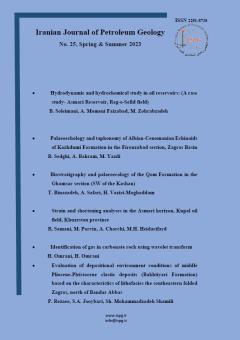-
-
List of Articles
-
Open Access Article
1 - Hydrodynamic and Hydrochemical Study in Oil Reservoirs: Asmari reservoir, Rag-E-Safid Oil Field
بهمن سلیمانی abdolah Momeni Faizhabad Mousa Zohrabzadeh -
Open Access Article
2 - palaeoechology and taphonomy of Albian-Cenomanian Echinoids of Kazhdumi Formation in Firouzabad section, Zagros Basin
Babak Sedghi Ali Bahrami Yazdi Yazdi -
Open Access Article
3 - Biostratigraphy and palaeoecology of Qom formation in the Ghamsr section (SW of the Kashan)
tayyeb binazadeh Amrollah Safari Hosyen Vaziri moghadam -
Open Access Article
4 - Strain and shortening analyses in the Asmari horizon, Kupal oil field, Khuzestan province
Babak Samani Mina Parvin Abbas Charchi Mohammad Hossein Heydarifard -
Open Access Article
5 - Identification of gas in carbonate rock using wavelet transform
Hassan Omrani Hashem omrani -
Open Access Article
6 - Evaluation of depositional environment conditions of middle Pliocene-Pleistocene clastic deposits (Bakhtiyari Formation) based on the characteristics of lithofacies the southeastern folded Zagros, north of Bandar Abbas city
Peyman Rezaei Seyedeh Akram Jooybari Shahrban Mohammadzadeh Shamili
-
The rights to this website are owned by the Raimag Press Management System.
Copyright © 2017-2025







